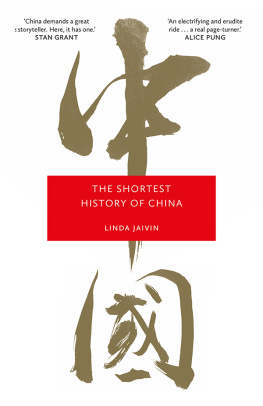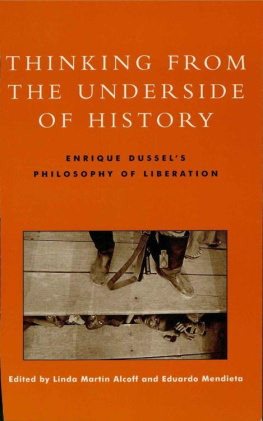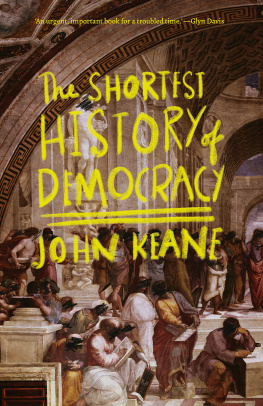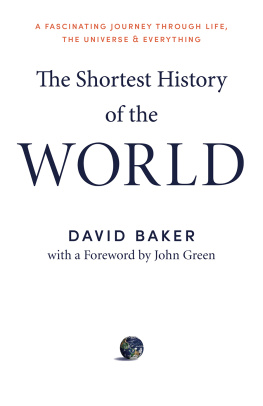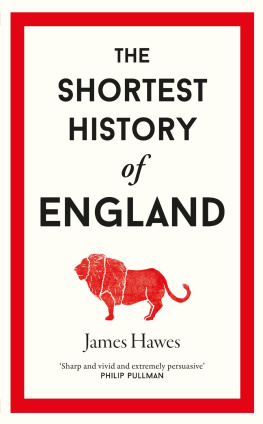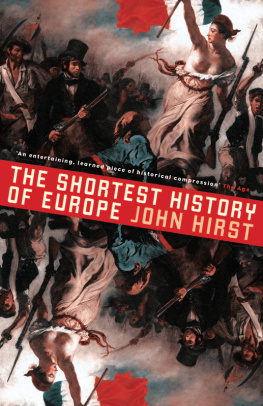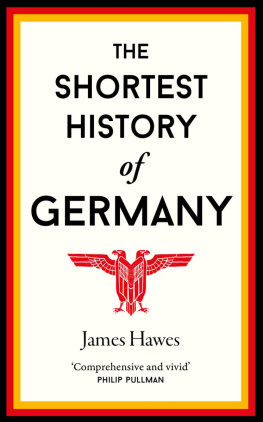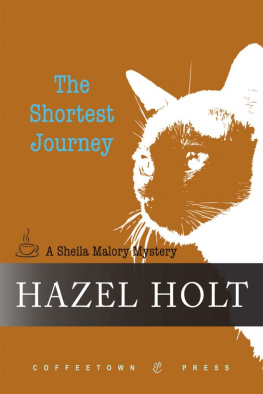Linda Jaivin - The Shortest History of China
Here you can read online Linda Jaivin - The Shortest History of China full text of the book (entire story) in english for free. Download pdf and epub, get meaning, cover and reviews about this ebook. year: 2021, publisher: Schwartz Books Pty. Ltd., genre: Non-fiction. Description of the work, (preface) as well as reviews are available. Best literature library LitArk.com created for fans of good reading and offers a wide selection of genres:
Romance novel
Science fiction
Adventure
Detective
Science
History
Home and family
Prose
Art
Politics
Computer
Non-fiction
Religion
Business
Children
Humor
Choose a favorite category and find really read worthwhile books. Enjoy immersion in the world of imagination, feel the emotions of the characters or learn something new for yourself, make an fascinating discovery.
- Book:The Shortest History of China
- Author:
- Publisher:Schwartz Books Pty. Ltd.
- Genre:
- Year:2021
- Rating:5 / 5
- Favourites:Add to favourites
- Your mark:
- 100
- 1
- 2
- 3
- 4
- 5
The Shortest History of China: summary, description and annotation
We offer to read an annotation, description, summary or preface (depends on what the author of the book "The Shortest History of China" wrote himself). If you haven't found the necessary information about the book — write in the comments, we will try to find it.
The Shortest History of China — read online for free the complete book (whole text) full work
Below is the text of the book, divided by pages. System saving the place of the last page read, allows you to conveniently read the book "The Shortest History of China" online for free, without having to search again every time where you left off. Put a bookmark, and you can go to the page where you finished reading at any time.
Font size:
Interval:
Bookmark:
Acknowledgements
This book is dedicated to Professor Lea Williams of Brown University, whose introductory course on East Asian history hooked me on the study of China in 1973, and whose insistence that I study the Chinese language changed my life.
My next great mentor, occasional collaborator, one-time husband and lifelong friend, Geremie R. Barm, has, ever since our first meeting in Hong Kong in 1981, guided my understanding of Chinese history, including how its sources, themes, concepts and even personalities have echoed down the ages. In particular, his theory of New Sinology, which stresses the role of language, culture and history in a multidisciplinary approach that engages with past and present debates and discussion across the Chinese world, deeply influences my own approach. His books and other writings, including on the chinaheritage.net website and its predecessor, chinaheritagequarterly.org, have been invaluable resources for this book. I am so grateful for the time he has taken to read a draft and comment on it.
David Brophy, Gloria Davies, Jaime FlorCruz, Olivier Krischer, Melissa Macauley, Antony Dapiran and Qin Yang have all taken time out of their busy lives to read some or all of this book in manuscript and offer invaluable advice. The writer Xue Yiwei went above and beyond with his detailed comments on my draft, as did Jeffrey Wasserstrom, himself a model popular historian of China. The book is infinitely better for all their expert oversight. I kowtow to them all. I alone am responsible for any errors and any views expressed herein.
The Australian Centre on China in the World at the Australian National University, of which Geremie was founding director, and where Im an associate and editorial consultant, has provided me, a freelance writer, with an academic base and colleagues. Among them is Dr Chen Mengxue, who took deep dives into classical and other sources to answer many demographic and other questions that had me stumped.
Jade Muratore was my right-hand woman on this project. I dont know what I would have done without her sharp editorial eye, knack for research and fact-checking, resourcefulness at sourcing illustrations and ability to read my handwriting. She takes credit too for inserting mammoth extinction into the timeline. Em Jaay double-checked all the diacritics for names and Chinese expressions. Thank you to Guo Jian as well.
I stood on the shoulders of giants to write this. I turned time and again to the work of Professor Jonathan D. Spence of Yale University, and to Jacques Gernets A History of Chinese Civilization, as well as the magnificent five-volume The Chinese Classics, annotated and translated by James Legge for the Hong Kong University Press. Ray Hwangs 1587: A Year of No Significance, and Ha Jins more recent, magnificent biography of the Tang poet Li Bai, The Banished Immortal, are among the many great works from which I drew inspiration and knowledge.
For the English translations of classic texts, I relied as much as possible on great translators such as Legge, Professor John Minford and the late Simon Leys (Pierre Ryckmans). I thank all of the authors and translators who have given permission for me to quote from their work here. Where the translator isnt credited in the notes, the translation is my own.
Publisher Chris Feik didnt know that writing a book like this had been my dream for more than forty years when he approached me to do it. Julia Carlomagno, my fabulous editor at Black Inc., made every step of the Long March to publication by my side; I owe more than I can express to her thoughtful comments, criticism and guidance. Im indebted to everyone at Black Inc., including designer Akiko Chan, proofreader Jo Rosenberg, publicist Sallie Butler and rights manager Erin Sandiford, who made this book happen despite Melbournes pandemic lockdowns.
Gaby Naher of Left Bank Literary has been the best and most steadfast of literary agents.
I live and work on the land of the Gadigal people, over which sovereignty has never been ceded. I also wrote some of this book on sovereign Darug and Gundungurra land, at the Varuna Writers House. Im grateful to the Eleanor Dark Foundation for maintaining Varuna, an oasis for writers, full of calm and care. Josemi furnishes my other oasis.
Generations of Chinese thinkers and poets, artists and inventors have deeply enriched the world and inspire me always. Ill leave you with this poem, written almost one thousand years ago by Su Dongpo:
Things were ever imperfect.
May we all live long,
May we all share,
Though myriad miles apart
The same fair moon.

ORIGINS
An Egg Hatches and a Civilisation Is Born
Far, far back in time, a popular Chinese creation story tells us, primal chaos congealed into an egg, in which the complementary cosmic energies of Ynand Yngthickened around a hairy, horned giant called Png. Eighteen thousand years passed. Pangu hatched fully formed, holding an axe, with which he hacked apart the Yin and Yang. The Yin became the earth beneath his feet, and the Yang, the sky. As he grew taller, he pushed the two further and further apart. After Pangu died, his flesh turned to soil, his sweat to rain and his breath to wind. His blood flowed as rivers and seas. His eyes became the sun and the moon. From his hair sprang plants and trees, and the fleas in his fur became animals and people.
Eons flew by. Warring deities laid waste to the heavens. Then Nw, the daughter of the celestial Jade Emperor, repaired the sky with coloured stones. Some say it was Nwa who created humans, fashioning them from clay.
AROUND 780,000 YEARS AGO, the Yellow River flowed much closer to the place we call Beijing than it does now, creating a fertile alluvial plain. Wild pigs, buffalo, sheep and deer roamed the lush meadows that spread out from Chinas second-largest river, and birds nested in forests dense with nut and fruit trees. In caves in the surrounding mountains, Peking Man (homo erectus pekinensis ) and other of humankinds Stone Age ancestors sheltered from sabre-toothed cats, wolves, bears, panthers and other predators, coming down to the flats to hunt and gather.
Two tribes, the Hu and Xi, from whom the ethnic majority Han Chinese claim descent, settled around the rivers middle and lower reaches. At some point around 13,000 years ago, one of them carved a bird from singed bone, two centimetres in length and balanced on a pedestal the most ancient animal sculpture ever found in East Asia.
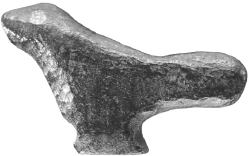
This carved bird, East Asias most ancient animal sculpture, was found in a pile of dirt left behind by a construction crew digging a well in Lngjng, Hnn province, in 2020.
Farming heralded the beginning of the Neolithic (New Stone) Age. In the relatively arid north, people cultivated millet and in the fertile ground of the south, rice. Farmers raised pigs, sheep and cattle, and domesticated wild dogs. They built homes of mudbrick, mud-plastered wood and stone. In some places, their dwellings featured glossy red pottery walls and roofs of fired mud and wood. The houses clustered in walled communities that would eventually dot the central plains. With more time for leisure, people crafted bowls, goblets and musical instruments of fired clay, decorating them with abstract patterns and zoomorphic figures. They carved jade, turquoise and bone into jewellery and objects for use in worship or burial rites.
Next pageFont size:
Interval:
Bookmark:
Similar books «The Shortest History of China»
Look at similar books to The Shortest History of China. We have selected literature similar in name and meaning in the hope of providing readers with more options to find new, interesting, not yet read works.
Discussion, reviews of the book The Shortest History of China and just readers' own opinions. Leave your comments, write what you think about the work, its meaning or the main characters. Specify what exactly you liked and what you didn't like, and why you think so.

